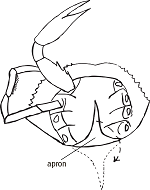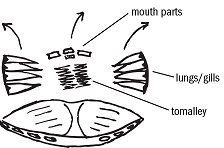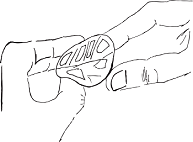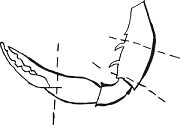Blue crabs are one of the most popular creatures caught in the Hudson River and in New York City waters. Because of industrial contamination, fish and crabs from these waters can contain chemicals at levels that may be harmful to your health.

- Because chemicals can have a greater effect on the development of young children and babies, women under 50 and children under 15 should not eat blue crabs from the Hudson River, and Upper Bay, Rivers and Kills surrounding New York City.
- Men over 15 and women over 50 face fewer health risks from some chemicals. For that reason, they can eat up to six crabs a week from the Hudson River and New York City waters.
- Crabs from the Long Island Sound, Jamaica Bay and the ocean are less contaminated and are a better choice for everyone.
 Step One
Step One: Once your crabs are cool enough to handle, start the picking process. Remove legs and claws and save for cracking.
Step Two: Using a knife, peel off the "apron" and discard.
 Step Four
Step Four: Scrape away the top layer removing the lungs (or "dead man's fingers"), face parts, and tomalley (mustard, brown/green stuff). Rinsing with water can help remove any remaining tomalley. The tomalley is where PCBs, metals and dioxins accumulate.
 Step Six
Step Six: There is crab meat in all of the leg sections, the claws, and the body chambers. A shrimp fork or nut pick is commonly used to remove the meat or squeeze it out.
 Step Three
Step Three: Holding the crab in your hand, separate the top and bottom shell. Discard the top shell.
 Step Five
Step Five: With your fingers, bend the crab in the middle, breaking the crab in half to expose the chambers of lump crab meat on each side.
 Step Seven
Step Seven: To get the meat out of the claws, use a household nut cracker or edge of a knife to gently break the claw open at the marks indicated and remove the meat with a small fork. Be gentle to avoid chunks of shell getting into the meat.
Step Eight: Dip in your favorite seasoning and enjoy!






